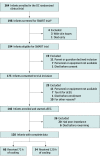Association Between Increased Seizures During Rewarming After Hypothermia for Neonatal Hypoxic Ischemic Encephalopathy and Abnormal Neurodevelopmental Outcomes at 2-Year Follow-up: A Nested Multisite Cohort Study
- PMID: 34882200
- PMCID: PMC8524352
- DOI: 10.1001/jamaneurol.2021.3723
Association Between Increased Seizures During Rewarming After Hypothermia for Neonatal Hypoxic Ischemic Encephalopathy and Abnormal Neurodevelopmental Outcomes at 2-Year Follow-up: A Nested Multisite Cohort Study
Abstract
Importance: Compared with normothermia, hypothermia has been shown to reduce death or disability in neonatal hypoxic ischemic encephalopathy but data on seizures during rewarming and associated outcomes are scarce.
Objective: To determine whether electrographic seizures are more likely to occur during rewarming compared with the preceding period and whether they are associated with abnormal outcomes in asphyxiated neonates receiving hypothermia therapy.
Design, setting, and participants: This prespecified nested cohort study of infants enrolled in the Optimizing Cooling (OC) multicenter Eunice Kennedy Shriver National Institute of Child Health and Human Development (NICHD) Neonatal Research Network trial from December 2011 to December 2013 with 2 years' follow-up randomized infants to either 72 hours of cooling (group A) or 120 hours (group B). The main trial included 364 infants. Of these, 194 were screened, 10 declined consent, and 120 met all predefined inclusion criteria. A total of 112 (90%) had complete data for death or disability. Data were analyzed from January 2018 to January 2020.
Interventions: Serial amplitude electroencephalography recordings were compared in the 12 hours prior and 12 hours during rewarming for evidence of electrographic seizure activity by 2 central amplitude-integrated electroencephalography readers blinded to treatment arm and rewarming epoch. Odds ratios and 95% CIs were evaluated following adjustment for center, prior seizures, depth of cooling, and encephalopathy severity.
Main outcomes and measures: The primary outcome was the occurrence of electrographic seizures during rewarming initiated at 72 or 120 hours compared with the preceding 12-hour epoch. Secondary outcomes included death or moderate or severe disability at age 18 to 22 months. The hypothesis was that seizures during rewarming were associated with higher odds of abnormal neurodevelopmental outcomes.
Results: A total of 120 newborns (70 male [58%]) were enrolled (66 in group A and 54 in group B). The mean (SD) gestational age was 39 (1) weeks. There was excellent interrater agreement (κ, 0.99) in detection of seizures. More infants had electrographic seizures during the rewarming epoch compared with the preceding epoch (group A, 27% vs 14%; P = .001; group B, 21% vs 10%; P = .03). Adjusted odd ratios (95% CIs) for seizure frequency during rewarming were 2.7 (1.0-7.5) for group A and 3.2 (0.9-11.6) for group B. The composite death or moderate to severe disability outcome at 2 years was significantly higher in infants with electrographic seizures during rewarming (relative risk [95% CI], 1.7 [1.25-2.37]) after adjusting for baseline clinical encephalopathy and seizures as well as center.
Conclusions and relevance: Findings that higher odds of electrographic seizures during rewarming are associated with death or disability at 2 years highlight the necessity of electroencephalography monitoring during rewarming in infants at risk.
Trial registration: ClinicalTrials.gov Identifier: NCT01192776.
Conflict of interest statement
Figures


Comment in
-
Identification and Treatment of Neonatal Seizures During Therapeutic Hypothermia and Rewarming-Reply.JAMA Neurol. 2022 May 1;79(5):530-531. doi: 10.1001/jamaneurol.2022.0439. JAMA Neurol. 2022. PMID: 35377417 No abstract available.
-
Identification and Treatment of Neonatal Seizures During Therapeutic Hypothermia and Rewarming.JAMA Neurol. 2022 May 1;79(5):530. doi: 10.1001/jamaneurol.2022.0436. JAMA Neurol. 2022. PMID: 35377420 No abstract available.
-
EBNEO commentary: Association between seizures during rewarming after hypothermia therapy for neonatal hypoxic-ischemic encephalopathy and abnormal neurodevelopmental outcomes.Acta Paediatr. 2022 Dec;111(12):2428-2429. doi: 10.1111/apa.16506. Epub 2022 Aug 10. Acta Paediatr. 2022. PMID: 35949059 Free PMC article. No abstract available.
References
Publication types
MeSH terms
Associated data
Grants and funding
- UG1 HD068263/HD/NICHD NIH HHS/United States
- U10 HD021373/HD/NICHD NIH HHS/United States
- UG1 HD087226/HD/NICHD NIH HHS/United States
- UL1 TR000042/TR/NCATS NIH HHS/United States
- UG1 HD053089/HD/NICHD NIH HHS/United States
- U10 HD040689/HD/NICHD NIH HHS/United States
- UG1 HD034216/HD/NICHD NIH HHS/United States
- UG1 HD027904/HD/NICHD NIH HHS/United States
- UG1 HD027880/HD/NICHD NIH HHS/United States
- UL1 TR000077/TR/NCATS NIH HHS/United States
- UG1 HD053109/HD/NICHD NIH HHS/United States
- UG1 HD027851/HD/NICHD NIH HHS/United States
- UL1 TR003167/TR/NCATS NIH HHS/United States
- UG1 HD040689/HD/NICHD NIH HHS/United States
- UG1 HD068278/HD/NICHD NIH HHS/United States
- U24 HD095254/HD/NICHD NIH HHS/United States
LinkOut - more resources
Full Text Sources
Medical
Miscellaneous

